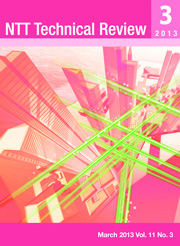
You need Adobe Reader 7.0 or later in order to read PDF files on this site.
If Adobe Reader is not installed on your computer, click the button below and go to the download site.

|

View from the Top
Feature Articles: Wireless Access Technologies that Enhance Convenience by Network Linkage
-
 Current Status, Issues, and Future Perspective of Wireless Home Networks Current Status, Issues, and Future Perspective of Wireless Home Networks

Abstract
Wireless access is now widely available in home networks. This allows network access from anywhere in the home. When wireless home networks become more secure and reliable and can be deployed more easily, more people will be able to use home network services. This article explains the current status and issues of home networks. It also introduces the concept of a user-centric wireless home network that is under development at NTT Network Innovation Laboratories.
-
 Public Wi-Fi Initiatives at NTT DOCOMO Public Wi-Fi Initiatives at NTT DOCOMO

Abstract
Smartphone use and data traffic have increased dramatically, and to cope with this, NTT DOCOMO is placing increasing importance on Wi-Fi services with the aim of raising customer satisfaction and accelerating data offloading to reduce network load. This article outlines NTT DOCOMO's public Wi-Fi service and introduces expanded coverage, free-access campaign, and enhanced convenience as specific examples of how NTT DOCOMO is promoting Wi-Fi use among its customers.
-
 High-speed Wireless LAN for Broadband Wireless Home Networks High-speed Wireless LAN for Broadband Wireless Home Networks

Abstract
This article introduces cooperative transmission techniques for wireless local area networks (WLANs) to mitigate interference between neighboring wireless home networks by establishing the cooperation of multiple WLAN access points (APs) on the next-generation home ICT (information and communications technology) platform. The cooperative transmission techniques achieve stable transmission of video data (such as for high-definition televisions (TVs)) and data traffic offloading of mobile devices such as smartphones from cellular networks to fixed broadband networks.
-
 Flexible Wireless System for User-centric Wireless Home Network Flexible Wireless System for User-centric Wireless Home Network

Abstract
We are developing a flexible wireless system with the aim of achieving a wireless home network that users can use without being aware of wireless systems and that will be easy for network operators to operate and maintain. This article introduces an overview of the flexible wireless system, use cases for it, and key technologies needed to achieve it.
-
 Scalable M2M Wireless Access System Scalable M2M Wireless Access System

Abstract
NTT Network Innovation Laboratories are collaborating in developing a machine-to-machine (M2M) wireless access method in order to expand the ways of communicating with machines. This method utilizes a standard system of simplified management that improves communication quality by controlling the access points and wireless terminals from a network. This article outlines the system being developed and introduces the functions and requirements of the wireless access M2M method. In addition, we describe how the method realizes the rapid construction of a wireless access network using existing Wi-Fi home devices in a disaster area.
Regular Article
-
 Virtual Sensor Construction Technique for Participatory Sensing Environments Virtual Sensor Construction Technique for Participatory Sensing Environments

Abstract
Much attention is being focused on participatory sensing, in which real-world data are collected using personal mobile devices as sensor nodes to sense various conditions of the world we live in. In this approach, sensor nodes are not controlled by a sensing system; they move and sense independently. Therefore, the sensing data may include noise or missing values and are therefore difficult to use as-is for applications. We are investigating a technique to construct virtual sensors in order to provide reliable and flexible sensing data. In this article, we introduce a construction technique that consists of three core methods to enhance data quality: participation promotion using our Top of Worlds technique, noise reduction, and missing value estimation. We also describe a simple demonstration we conducted that shows how these factors enhance data quality.
Global Standardization Activities
-
 Trends in the International Standardization of HVDC Power Feeds Trends in the International Standardization of HVDC Power Feeds

Abstract
Higher-voltage direct current (HVDC) power feeds are attracting attention as an efficient means of supplying 380-V DC electricity to datacenters and telecommunications facilities, and it is expected that this technology will eventually be put to practical use in many places worldwide. In this article, we describe the characteristics of HVDC power feeds and the international standardization efforts related to this technology, including an overview of ITU-T recommendation L.1200 of May 2012 ("Direct current power feeding interface up to 400 V at the input to telecommunication and ICT equipment").
External Awards
|
